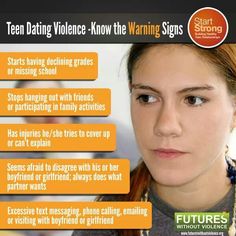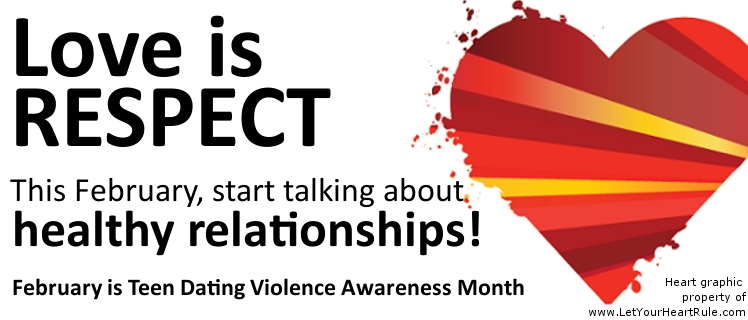Teen Dating Violence Awareness Month

The teenage years are accompanied by diverse challenges and opportunities. A few of the factors critical to healthy development are: self-esteem, personal agency, boundaries, and accountability. Youth observe family, media, peers, and adult role models to assemble their sense of self and expectations in relationship to others. Unfortunately, far too many teens are exposed to abuse in their intimate relationships, precisely as this process is occurring. February is Teen Dating Violence Awareness Month; an opportunity to increase understanding and dialogue about this critical topic.
What is Teen Dating Violence (TDV)? Dating violence is a pattern of behaviors used to maintain power and control over another person. Abuse comes in many forms---physical, emotional/verbal, financial, sexual, and digital. Though abuse in teenage relationships mirrors adult domestic violence in most ways, teens may face additional challenges in recognizing the warning signs and seeking safety. In fact, girls and young women between the ages of 16 and 24 experience the highest rate of intimate partner violence, almost triple the national average. (Department of Justice, Bureau of Justice and Statistics, 2006) One in three adolescent girls in the United States is a victim of physical, emotional or verbal abuse from a dating partner each year, a figure that far exceeds victimization rates for other types of violence affecting youth (Davis, 2008). There are not adequate statistics on the prevalence of male victimization but abuse can happen in any relationship regardless of gender, sexuality, socioeconomic status, or race.
Research shows that without intervention, TDV may result in long-term effects. High school students who experience physical violence in a dating relationship are more likely to use drugs and alcohol, are at greater risk of suicide and are much more likely to carry patterns of abuse into future relationships. (Family Violence Prevention Fund and Advocates for Youth, 2004)(2) In addition, people victimized by a dating partner are more likely to engage in risky sexual behavior and unhealthy dieting behaviors and the experience may disrupt normal development of self-esteem and body image (Jay G. SIlver, Anita Raj, Lorelei A. Mucci, & Jeanne E Hathaway, 2001). (3)
By providing young people with healthy relationship skills and by changing attitudes that support violence, we recognize that dating violence can be prevented. Underscoring the importance of awareness, nearly half of teens who experience dating violence report that incidents of abuse took place in a school building or on school grounds; and, only 33% of teens who are in an abusive relationship ever tell anyone about the abuse (Liz Claiborne, Inc, 2005)(4). In contrast to the prevalence, 81% of surveyed parents either believes TDV is not an issue or admit they do not know if it is one. (M, PhD, & PhD, 2005) (5)
It is essential that we as a community support our young people. We can move toward ending TDV by--- empowering young people to develop healthier relationships, assisting victims in accessing the information and supportive services they need, creating better and more resources for young people in need, instituting effective intervention and prevention policies in schools and engaging in discussions with family members and peers to promote awareness and prevention of the quiet epidemic of TDV.
If you would like more information on how to talk with your teen, or would like to promote this topic at your school, please contact:
Project Sanctuary
(707) 961-1507-Fort Bragg/ (707) 462-9196-Ukiah
http://www.loveisrespect.org/resources/start-talking/
https://www.breakthecycle.org/back2school-adults
###
Project Sanctuary, Inc. is a private, not-for-profit organization with the mission to prevent domestic violence and sexual assault in Mendocino County through advocacy, crisis response, community collaboration, education, and shelter. Lia Holbrook is the Coast Services Director at Project Sanctuary in Fort Bragg.
Full Citations:
Department of Justice, Bureau of Justice and Statistics, Intimate Partner Violence in the United States, 1993-2004. Dec. 2006.
Davis, Antoinette, MPH. 2008. Interpersonal and Physical Dating Violence among Teens. The National Council on Crime and Delinquency Focus. Available at http://www.nccdcrc.org/nccd/pubs/2008_focus_teen_dating_violence.pdf.
Jay G. Silverman, PhD; Anita Raj, PhD; Lorelei A. Mucci, MPH; Jeanne E. Hathaway, MD, MPH, “Dating Violence Against Adolescent Girls and Associated Substance Use, Unhealthy Weight Control, Sexual Risk Behavior, Pregnancy, and Suicidality” JAMA. 2001;286(5):572-579. doi:10.1001/jama.286.5.572
Decker M, Silverman J, Raj A. 2005. Dating Violence and Sexually Transmitted Disease/HIV Testing and Diagnosis Among Adolescent Females. Pediatrics. 116: 272-276.
Liz Claiborne Inc., conducted by Teenage Research Unlimited, (February 2005)
“Women’s Health,” June/July 2004, Family Violence Prevention Fund and Advocates for Youth, http://www.med.umich.edu/whp/newsletters/summer04/p03-dating.html.

